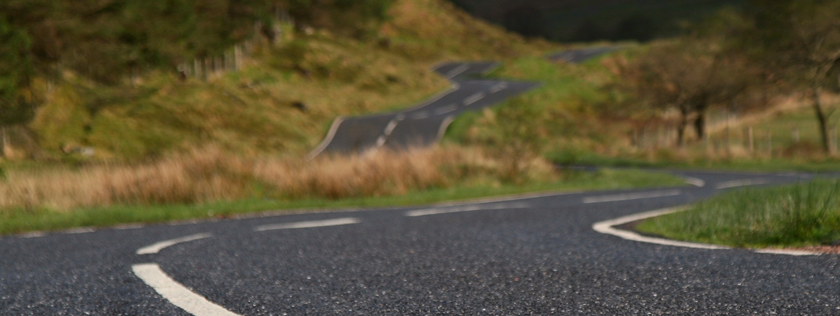Why are Aberdeenshire roads the most dangerous roads in Scotland?

New figures released from Transport Scotland show that in 2014 more people were killed in road traffic accidents in Aberdeenshire than in any other region of Scotland.
In 2014 Aberdeenshire alone reported 25 road traffic accident deaths with the Highland Council reporting the next highest number at 19.
So why are there so many road traffic accidents on Aberdeenshire roads?
The problem with the roads in Aberdeenshire and the surrounding Highlands is the location itself. Most of Aberdeenshire is rural countryside with many of the roads starting life as mud tracks and ancient mountain passes but are now being used as main commuter roads connecting the many towns and villages. These roads were never intended for large volumes of traffic, or large vehicles such as lorries and vans.
Higher speed limits, sharp bends and prolonged straights
Most of the roads around Aberdeenshire are single carriageway minor roads cutting through the rolling farmland. These roads can be treacherous as they have higher speed limits of up to 60mph, sharp bends and often winding with prolonged straight roads tempting drivers to drive fast. These treacherous roads are also shared by everything from tractors and lorries, to sports cars and motorbikes with overtaking opportunities limited.
Sadly, Transport Scotland has found that car accidents are most dangerous where the speed limit is higher but the roads are narrow, steep and winding.
Add to this the adverse weather conditions and busy varied traffic heightens the problem making many of these roads even more treacherous.
Transport Scotland identified that rural, non built-up roads (roads out with built up areas where the speed limit is over 40mph) accounted for over a third (39%) of reported road traffic accident casualties and two thirds (64%) of those killed.
Given Aberdeenshire’s relatively small size, there is a disproportionately high number of non-built up roads in Aberdeenshire connecting the many towns such as Peterhead, Banff, Stonehaven and Inverurie and villages such as Crathie, Gardenstown and Pennan, which could partly explain why Aberdeenshire reports the highest number of road traffic accident casualties and fatalities.
Drivers treating country roads like racetracks
However, it is not just the roads themselves which are the issue, drivers may also be at fault when it comes to road traffic accidents on rural roads across Scotland. It is vital that people remember that these rural roads are not race tracks and are statistically the most dangerous type of road. Car occupants are twice as likely to be killed on a non-built up road and cyclists are three times as likely.
Reduce your Speed, Reduce the Risk
Research carried out by Brake - the road safety charity and Digby Brown Solicitors last year found:
- 1 in 3 drivers admitted driving too fast for safety on country roads, by speeding, taking bends fast or overtaking.
- 4 in 10 have admitted to having had a near-miss on country roads, while driving, walking or cycling.
This clearly shows that as drivers we feel a false sense of security and are prone to taking risks when driving on rural roads, especially if the route is familiar. Fast traffic on country roads not only puts drivers and passengers at risk, but also cyclists, walkers and horse riders.
Although country roads can have a speed limit of 60mph, it is not always suitable to drive at this speed. Drivers need to judge the road itself and not only the speed limit in order to avoid being injured in a road traffic accident.
Speed isn’t the only issue. Distractions such as mobiles phone can be deadly.
It is recognised that drivers using a hands-free or handheld mobile phone are 50% slower to recognise and react to hazards to prevent a road accident. Research has shown that if you are using your mobile phone while driving, your reaction times are worse than if you drive under the influence of alcohol.
Digby Brown Solicitors supports Brake’s campaign upon the Government to lower the speed limit on rural roads to a maximum of 50mph. Digby Brown also supports Brake’s campaign to require authorities to implement lower limits when there are particular risks identified.
Digby Brown Solicitors recommends driving smart
- Prepare thoroughly and plan the best and safest route.
- Drive as though something could be coming around the next corner.
- Anticipate potential hazards. Look out for upcoming bends, hidden dips, blind summits and concealed entrances.
- Stay well under the speed limit and slow down for bends, braking before the bend, not into the bend.
- Give yourself time to react to unexpected hazards.
- If the road is wet or slippy, allow more time to stop.
- Despite being familiar with a road, don’t take it for granted as the road conditions can change.
- Mobile phones are switched off before you drive, out of sight and out of reach.
- Before using mobile phone, park safely with your engine off.
- Don’t call other people when you know they are driving.
Learn more about Digby Brown's support for Brake road safety charity or find out how we can help if you have been injured in a car crash.